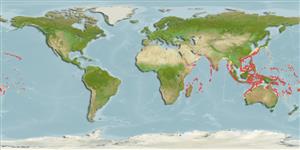Classification / Names
Common names from other countries
Main reference
Size / Weight / Age
Max length : 110 cm TL male/unsexed; (Ref. 5484); common length : 79.0 cm SL male/unsexed; (Ref. 37816); max. published weight: 11.3 kg (Ref. 4887)
Environment
Marine; reef-associated; depth range 100 - 330 m (Ref. 37816)
Climate / Range
Tropical, preferred 27°C (Ref. 107945); 35°N - 28°S, 38°E - 150°W (Ref. 55)
Distribution
Indo-Pacific: East Africa to the Hawaiian Islands, north to the Ryukyu and Ogasawara islands, south to Australia. Southeast Atlantic: Port Alfred, South Africa (Ref. 11228).
Countries | FAO areas | Ecosystems | Occurrences | Introductions
Short description
Dorsal
spines
(total): 10;
Dorsal
soft rays
(total): 10-11;
Anal
spines: 3;
Anal
soft rays: 8. Maxilla extending to below middle of eye; interorbital space flattened. Dorsal and anal fins without scales. Generally blue-gray or mauve to overall reddish; fins yellowish to reddish except pelvic and anal fins which are sometimes whitish; margin of maxilla black.
IUCN Red List Status (Ref. 115185)
Threat to humans
Harmless
Human uses
Fisheries: commercial; gamefish: yes
More information
ReferencesAquacultureAquaculture profileStrainsGeneticsAllele frequenciesHeritabilityDiseasesProcessingMass conversion
Tools
Special reports
Download XML
Internet sources
Estimates of some properties based on models
Phylogenetic diversity index
PD50 = 0.7500 many relatives (e.g. carps) 0.5 - 2.0 few relatives (e.g. lungfishes)
Trophic Level
4.1 ±0.57 se; Based on food items.
Resilience
Medium, minimum population doubling time 1.4 - 4.4 years (K=0.16)
Vulnerability
High vulnerability (58 of 100)
Price category
